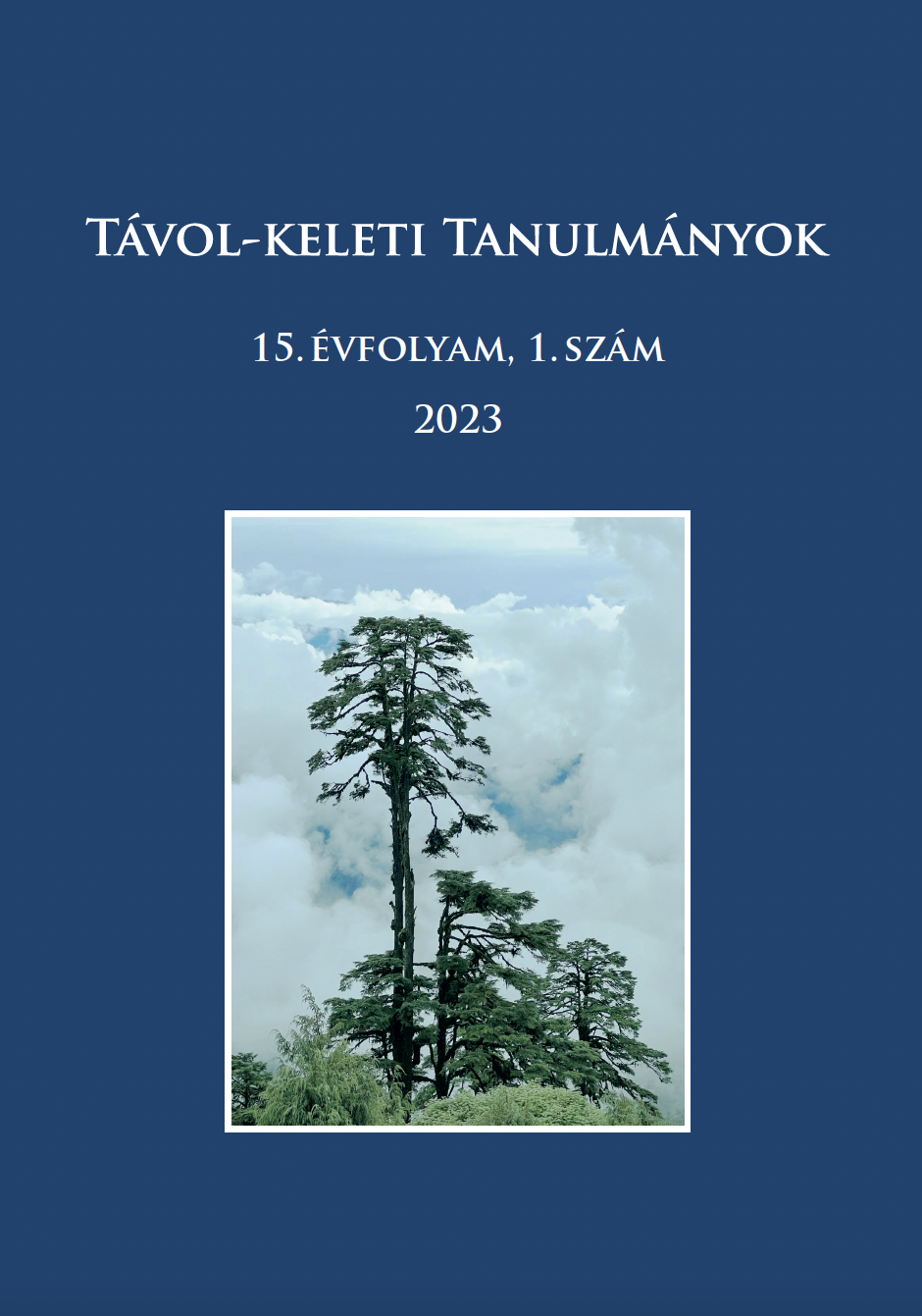Published 2023-05-16
Keywords
- Samantabhadra,
- Buddhāvataṃsaka-sūtra,
- Lotus Sutra,
- Samantabhadra's practice,
- Śikṣānanda
- Vairocana ...More
How to Cite
Copyright (c) 2023 Imre Hamar

This work is licensed under a Creative Commons Attribution-NonCommercial 4.0 International License.
Abstract
Samantabhadra is one of the celestial bodhisattvas of Mahāyāna Buddhism who has become the object of worship in East Asian Buddhism and has been represented in various iconographic appearances in East Asian art since the 5th century CE. The earliest source on Samantabhadra is the Lotus sūtra, which was first translated by Dharmarakṣa in 286 CE under the title Zheng fahua jing正法華經, and later the famous translator Kumārajīíva (344–413) also translated it in 406 under the title Miaofa lianhua jing 妙法蓮華經. Samantabhadra appears in the last chapter of the scripture, ‘The Samantabhadra’s encouragement’ (‘Puxian pusa quanfa pin’ 普賢菩薩勸發品), which encourages all living beings to practice the teaching of the Lotus sūtra. Presumably, the Samantabhadra visualisation sūtra (Guan Puxian pusa xingfa jing 觀普賢菩薩行法經, T.277), which provides a very detailed depiction of the appearance of Samantabhadra bodhisattva riding his six-tusked elephant, was written under the increasing influence of the Lotus sūtra. This apocryphal scripture includes elements of visualisation practices that probably originated in Central Asia and a repentance ritual to erase all sins committed in present and previous lives. The third source of the Samantabhadra cult is the Buddhāvataṃsaka-sūtra, which was first translated into Chinese by Buddhabhadra (359-429) in 420 in 60 fascicles and later by Śikṣānanda (652-710) in 699 in 80 fascicles. The special feature of this scripture is that most of the time bodhisattvas deliver Buddha’s teachings. One of these bodhisattvas is Samantabhadra, who preaches one-third of the entire scripture. The titles of two chapters of the Buddhāvataṃsaka-sūtra mention the name of Samantabhadra. One of them is ‘Samantabhadra’s samādhi’ (‘Puxian sanmei’ 普賢三昧), and the other one is ‘Samantabhadra’s practice’ (‘Puxian xing’ 普賢行). The Tibetan version of the Buddhāvataṃsaka-sūtra translated in the 9th century includes another chapter related to Samantabhadra titled ‘The teaching of Samantabhadra’ (‘Kun tu bzang pos bstan pa’), which is not found in either versions of the Chinese translations of the Buddhāvataṃsaka-sūtra. However, Śikṣānanda translated it into Chinese as an independent sūtra under the title Da fangguang Puxian suo shuo jing 大方廣普賢所說經 (T. 298). This article includes the Hungarian translations of the chapters ‘Samantabhadra’s samādhi’ and ‘The teaching of Samantabhadra’ from Chinese sources with references to the Tibetan versions of the texts.
References
- Dessein, Bart 2003. „The Glow Of The Vow Of The Teacher Samantabhadra ’Puxian Pusa Xing Yuan Zan’ (T.297) Samantabhadrācāryapraṇidhānarāja.” Acta Orientalia Academiae Scientiarum Hungaricae 56.2/4: 317–338. https://doi.org/10.1556/AOrient.56.2003.2-4.16
- Buswell, Robert E. 1990. Chinese Buddhist Apocrypha. Honolulu: University of Hawaii Press. https://doi.org/10.1515/9780824842611
- Cleary, Thomas 1993. The Flower Ornament Scripture: A translation of the Avatamsaka sutra. Boston: Shambala.
- Greene, Eric Matthew 2021a. Chan Before Chan: Meditation, Repentance, and Visionary Experience in Chinese Buddhism. Honolulu: University of Hawaii Press. https://doi.org/10.2307/j.ctv16t66ts
- Greene, Eric Matthew 2021b. The Secrets of Buddhist Meditation: Visionary Meditation Texts from Early Medieval China. Honolulu: University of Hawaii Press. https://doi.org/10.2307/j.ctv16t66q7
- Hamar Imre 2007. „The History of the Buddhāvataṃsaka-sūtra: Shorter and Larger Texts.” In: Hamar, Imre (ed.) Reflecting Mirrors: Perspectives on Huayan Buddhism. Wiesbaden: Harrassowitz Verlag, 139–167.
- Hamar Imre 2010. „Wutaishan, a buddhizmus szent hegye: Hegykultusz Kínában.” Vallástudományi Szemle 2: 20–30.
- Hamar Imre 2017. „Buddhista szent hegyek Kínában: a Wutaishan és a Niutoushan.” In: Gelle Zsóka, Hamar Imre, Kósa Gábor (szerk.) Szent hegyek a buddhizmusban. Bibliotheca Buddhologica Budapestinensis 1. Budapest: ELTE BTK, a Buddhizmus-kutatás Központja, 77–93.
- Hamar Imre 2019. „A dunhuangi hatagyarú elefánton ülő Samantabhadra ábrázolásán fellelhető indiai és közép-ázsiai hatások.” In: Csibra Zsuzsa (szerk.) Művészet, vallás, kultúra: Sinológiai tanulmányok Miklós Pál emlékére. Konfuciusz Könyvtár 3. Budapest: ELTE Konfuciusz Intézet, 31–42.
- Hamar Imre 2020. „Szamantabhadra vizualizációs szútra.” In: Hamar Imre, Takó Ferenc (szerk.) Kínai bölcselet és művészet – Tanulmányok Tőkei Ferenc emlékére. Konfuciusz Könyvtár 4. Budapest: ELTE Konfuciusz Intézet, 123–163.
- Howard, Angela Falco 1986. The Imagery of the Cosmological Buddha. Leiden: Brill.
- Kiss Mónika 2015. „Fugen Enmei bosatsu ikonográfiai meghatározásának néhány problematikus pontja.” Távol-Keleti Tanulmányok 2014/1–2: 67–92.
- Kiss Mónika 2017. „Szútrák a hosszú élethez Amoghavajra fordításában: A Fugen Enmei szútra kutatásának margójára.” Távol-Keleti Tanulmányok 2016/2: 87–126. https://doi.org/10.38144/TKT.2016.2.4
- Kiss Mónika 2019. „Fugen Enmei kínai eredete: Két indiai mester, két hagyomány?” In: Csibra, Zsuzsanna (szerk.) Művészet, vallás, kultúra: Sinológiai tanulmányok Miklós Pál emlékére. Budapest: ELTE Konfuciusz Intézet, 173–187.
- Osto, Douglas 2010. „A New Translation of The Sanskrit Bhadracarī With Introduction and Notes.” New Zealand Journal of Asian Studies 12/2: 1–21.
- Soper, Alexander C. 1958. Literary Evidence for Early Buddhist Art in China. Ascona, Switzerland: Artibus Asiae Supplementum.
- Stevenson, Daniel B. 1987. „The T’ian-t’ai Four Forms of Samādhi and late North-South Dynasties, and Early T’ang Buddhist devotionalism.” Ph.D. diss., Columbia University.
- Yamabe Nobuyoshi 1999. „The Sutra on the Ocean-like Samadhi of the Visualization of the Buddha: The Interfusion of the Chinese and Indian Cultures in Central Asia as Reflected in a Fifth Century Apocryphal Sutra.” Ph.D. diss., Yale University.

